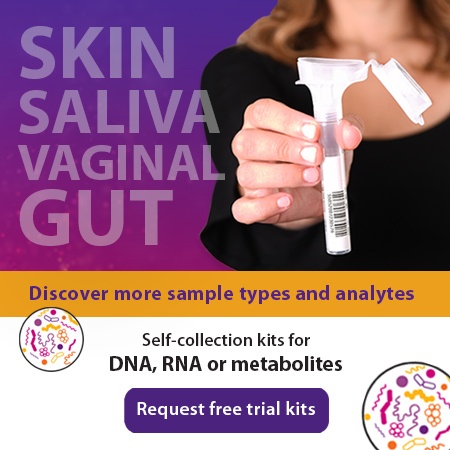2020-03-27
Dr. Carolyn Compton, former director of the OBBR National Cancer Institute, said
“We now have the technical ability to get the wrong answers with unprecedented speed. If we put the wrong stuff into the front end of our analytical pipeline…we’ll pollute the scientific literature with incorrect data that will take us a long time to sort out. This is a crisis that requires disruptive innovation.”[1]
We could not agree more. DNA GenotekTM has over 20 years of experience developing products for genomics, microbiome, and infectious disease applications and has expertise in non-invasive collection from diverse sample types. With any sample type, it is important to have the best sequencing results to obtain meaningful and accurate insights.
In this podcast, I spoke with Mike Tayeb and Brice LeFrançois, two experts from DNA GenotekTM’s research and development team. Both highlighted the best practices they use in the lab with saliva and stool samples to get optimal sequencing results. Mike focused his discussions on saliva samples for human genomics and Brice on the gut microbiome. You can listen to the full podcast here and selected highlights for the microbiome enthusiasts are captured below:
In today’s blog, I will highlight the microbiome portion of the podcast with Brice LeFrançois, covering how to get optimal sequencing results with fecal samples.
Best practices for the extraction of fecal samples.
The study of the gut microbiome has taken the scientific community by storm. Similar to the study of human genomics with saliva, it is important to produce accurate data that relies heavily on what happens before sequencing. For example, with stool samples, the extraction step is incredibly important.
Is it true that bias (taxonomic profile might not be representative) can be introduced if the fecal sample was extracted poorly?
Brice explained, how a paper recently published in Nature Biotechnology looked at over 20 methods commonly used to extract DNA from fecal samples and showed that extraction was the variable with the most impact on metagenomics results. [2]
According to Brice, this is not surprising, since fecal samples are quite different from saliva or other microbiome samples and can be challenging to process for many reasons:
- They typically contain a very high bacterial load with a significant proportion of hard to lyse gram-positive bacteria.
- These bacterial cells are mixed with a highly variable solid matrix (stool matter) that can protect cells from lysis.
- Stool samples are rich in inhibitors and interfering substances, which if not removed properly, can negatively affect enzymatic activities implicated in the downstream processing.
“When looking for an extraction protocol to process fecal samples, I recommend choosing one that can equally lyse both gram-positive and gram-negative bacteria to minimize the extraction bias. This is critical to ensure that you will get a representative taxonomic profile of the microbial species present in your sample. I would also make sure that the protocol yields large quantities of high-quality DNA to ensure optimal compatibility with downstream processing.”
It is also important to consider extraction compatibility as a potential source of bias. Most extraction kits have been optimized to process bulk stool samples, but many researchers choose to use stabilizing solutions such as OMNIgene·GUT to simplify the fecal collection process for large cohorts.
“During the extraction step, the stabilizing solution is added along with the stool material to the lysis buffer and can affect lysis efficiency. We’ve seen stabilizing solutions having a large impact on DNA yields/lysis in the past, so I think it’s critical to choose the extraction method best suited to your particular sample format.”
Related Blog: Why is an optimal DNA extraction important for microbial profiling?
Things to consider regarding the extraction and preparation of fecal samples?
Many of the current extraction methods used to extract DNA from stool samples are bead beating based and rely heavily on mechanical lysis of bacterial cells.
“These methods can be very efficient at lysing gram-positive bacteria, but they can also result in significant shearing of the DNA if mechanical forces are too strong. Libraries isolated from overly sheared DNA tend to yield shorter DNA fragments because the fragmentation step of most protocols is optimized for high-molecular-weight DNA. Shorter fragments/read lengths can be a major issue when someone is interested in the de novo assembly of genomes. Also, excessively sheared DNA is less likely to perform well in full-length 16S sequencing.”
What would you recommend as the best extraction method for fecal samples?
The answer to this question depends on the type of sequencing you’re interested in performing on your sample type.
“For standard sequencing applications using Illumina short-read sequencing applications, our current recommendation is the PowerFecal-Pro DNA Kit from QIAGEN, based on its ability to efficiently lyse Gram-positive bacteria and to isolate large quantities of pure high-molecular-weight DNA. The RBB method developed by Yu and Morrison [3] is also very good. Both methods are bead beating-based and compatible with samples collected in OMNIgene·GUT. However, keep in mind that the field is evolving so rapidly that there might be a better alternative in a few months from now.”
Related Blog: Choosing the best DNA extraction method in human gut microbiome community profiling
In conclusion: choosing the proper extraction method is key
“For gut microbiome studies, the quality of the DNA used for library prep is critical to getting reliable sequencing results that will adequately answer the questions of a given project. The choice of a proper extraction method is key because it will ensure the recovery of DNA suitable for the chosen sequencing platform while minimizing bias as much as possible."
If you have any questions or want to learn more about the best practices with stool samples to get the best sequencing results, you can email us at info@dnagenotek.com
References:
[1] https://www.akampion.com/news/2010/05/food-for-thought-why-tissue-sample-quality-matters-for-personalized-medicine/
[2] https://www.researchgate.net/publication/320175013_Towards_standards_for_human_fecal_sample_processing_in_metagenomic_studies
[3] Yu and Morrison. Improved extraction of PCR-quality community DNA from digesta and fecal samples. Biotechniques. 36(5):808-12 (2004).



